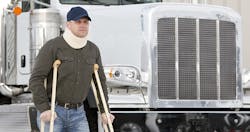More Good News: Work-related Fatalities Slipped in 2017
There were a total of 5,147 fatal work injuries recorded in the United States in 2017, down slightly from the 5,190 that were registered in 2016, according to the annual report issued by the U.S. Bureau of Labor Statistics. That is still up substantially from the previous 14-year low of 4,551 in 2009.
BLS also reports that the fatal injury rate decreased to 3.5 per 100,000 full-time equivalent (FTE) workers from 3.6 in 2016. A total of 27 states had fewer injuries in 2017 than 2016, while 21 states and the District of Columbia had more; California and Maine had the same number as 2016. A total of 192 metropolitan statistical areas (MSAs) had five or more fatal work injuries in 2017.
The bureau reported that recordable injuries and illnesses in the private sector continued their 14-year slide in 2017. Employers had 2.8 total recordable cases per 100 workers, barely half the number reported in 2003, BLS notes.
The transportation and material moving occupations, and construction and extraction occupation groups accounted for 47% of worker deaths in 2017. Transportation incidents remained the most frequent fatal event in 2017, accounting for 2,077 (40%) occupational fatalities, only down by six from 2016.
Within the occupational subgroup driver/sales workers and truck drivers, heavy and tractor-trailer truck drivers had the largest number of fatal occupational injuries with 840. This represented the highest value for heavy and tractor-trailer truck drivers since the occupational series began in 2003, the bureau notes.
On the other hand, fatal occupational injuries in the private manufacturing industry and wholesale trade industry were the lowest since this series began in 2003.
Looking at the causes of deaths, BLS says fatal falls were at their highest level in the 26-year history of the Census of Fatal Occupational Injuries (CFOI), accounting for 887 (17%) worker deaths. Violence and other injuries by persons or animals decreased 7% in 2017 with homicides and suicides decreasing by 8% and 5%, respectively.
Unintentional overdoses due to nonmedical use of drugs or alcohol while at work increased 25% from 217 in 2016 to 272 in 2017. This was the fifth consecutive year in which unintentional workplace overdose deaths have increased by at least 25%, the bureau points out.
Contact with objects and equipment incidents were down 9% (695 in 2017 from 761 in 2016) with caught in running equipment or machinery deaths down 26% (76 in 2017 from 103 in 2016). In addition, fatal occupational injuries involving confined spaces rose 15% to 166 in 2017 from 144 in 2016. Crane-related workplace fatalities fell to their lowest level ever recorded with 33 deaths in 2017.
BLS also says 2,989 of the total 5,147 fatal injuries in 2017 were incurred by workers over the age of 44, almost the same as the previous year’s 2,993. In addition, 15% of the fatally-injured workers in 2017 were age 65 or over – a series high. In 1992, the first year CFOI published national data, that figure was 8%. These workers also had a higher fatality rate than other age groups in 2017.
Looking at the different ethnic groups, fatalities incurred by non-Hispanic Black or African-American workers and non-Hispanic Asian workers each decreased 10% from 2016 to 2017.
In term of industry sectors, BLS reports that workplace fatalities in the private mining, quarrying, and oil and gas extraction industry increased 26% to 112 in 2017, up from a series low of 89 in 2016. Over 70% of these fatalities were incurred by workers in the oil and gas extraction industries.
Fishers and related fishing workers and logging workers had the highest published rates of fatal injury in 2017. There were 258 fatalities among farmers, ranchers and other agricultural managers in 2017. About 63% of these farmers were age 65 and over (162) with 48 being age 80 or over. Of the 258 deaths, 103 involved a farm tractor.
Grounds maintenance workers (including first-line supervisors) incurred 244 fatalities in 2017. This was a small decrease from the 2016 figure (247) but was still the second-highest total since 2003. A total of 36 deaths were due to falls from trees, and another 35 were due to being struck by a falling tree or branch.
In what we can hope is a good sign, police and sheriff’s patrol officers also experienced a decrease in 2017, incurring a total of 95 fatal occupational injuries in 2017, fewer than the 108 fatalities in 2016.
About the Author

David Sparkman
founding editor
David Sparkman is founding editor of ACWI Advance (www.acwi.org), the newsletter of the American Chain of Warehouses Inc. He also heads David Sparkman Consulting, a Washington D.C. area public relations and communications firm. Prior to these he was director of industry relations for the International Warehouse Logistics Association. Sparkman has also been a freelance writer, specializing in logistics and freight transportation. He has served as vice president of communications for the American Moving and Storage Association, director of communications for the National Private Truck Council, and for two decades with American Trucking Associations on its weekly newspaper, Transport Topics.
